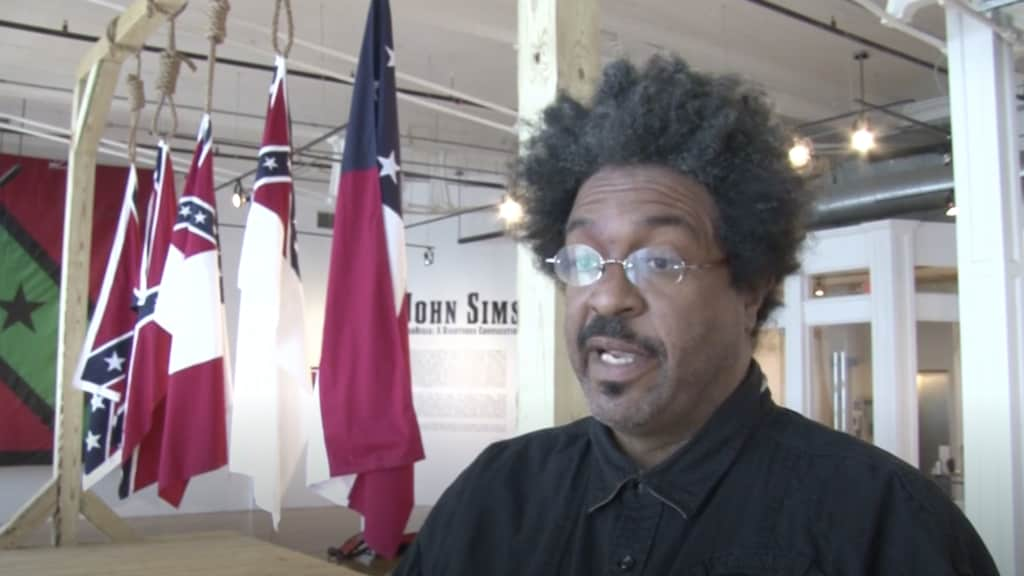We bring news that matters to your inbox, to help you stay informed and entertained.
Terms of Use and Privacy Policy Agreement
WELCOME TO THE FAMILY! Please check your email for confirmation from us.
OPINION: Sims, who died in December at age 54, was famous for fearlessly reimagining and repurposing toxic symbols of white supremacy.
Editor’s note: The following article is an op-ed, and the views expressed are the author’s own. Read more opinions on theGrio.
Of the many people we lost in 2022, one whose passing flew under the radar was multimedia artist, mathematician, Afrofuturist, writer, producer and activist John Sims, who died Dec. 11 at age 54. Sims — known for his ritual burning, burying and rethinking of the confederate flag — was an important Black artist who spoke out for justice with his work. His legacy reminds us of the important role of the Black artist — to express our culture and tell our stories, and to speak truth to power in a racist society.
Born and raised in Detroit and a graduate of Antioch College, Sims was a resident of Sarasota, Florida. A friend and colleague, John never ceased to amaze and inspire me with his creativity and the depth and breadth of his artistic vision. I had the honor to collaborate with him on a number of projects on issues ranging from electoral politics to the coronavirus and Kanye West.
It was hard to place Sims in a box because he worked across platforms in a multimedia environment. For example, John blended math and art with his Black Pi-inspired quilts, and in the midst of the COVID pandemic, he designed Korona Killa, a COVID-themed video game reminiscent of the classic game Space Invaders.
Sims was especially known for his work on confederate symbols, toxic symbols of white supremacy, terrorism and trauma for Black folks. His ritual burning and burying of the confederate flag every Memorial Day was an example of the artist engaged in protest. But he did not leave it there. John seized control of the confederate flag — a symbol that continues to haunt America — by repurposing it for Black people and painting it red, black and green.
In Freedom Memorial at Gamble Plantation, he envisioned reclaiming a former Florida plantation, now a state park, and transforming it into a memorial to the enslaved Black people and “a place of possible transformative healing, where the slave becomes free, the shamed becomes washed and faith is restored in the universal sovereignty of human rights.”
But Sims expressed himself through music, too. On his album “AfroDixieRemixes,” John repurposed the confederate song “Dixie” with reimagined versions in musical genres of the African diaspora such as R&B, gospel, blues, hip-hop, funk, samba and others. A blues/jazz rendition on the album is a chilling reminder of Billie Holiday’s 1939 recording of “Strange Fruit.” John created, directed and produced “AfroDixieRemixes” and even designed the album cover.
Black art is both personal and political. And at their greatest, Black artists are here for the culture, for Black pride and uplift of the community. When we consider the Harlem Renaissance of the 1920s and 1930s and the Black Arts Movement of the 1960s and 1970s, Black artists saw their role as to tell our stories, reflect our experiences and help make us free. In his essay “Blueprint for Negro Writing,” Richard Wright asked: “Shall Negro writing be for the Negro masses, moulding the lives and consciousness of those masses toward new goals, or shall it continue begging the question of the Negroes’ humanity?”
At this very moment — in light of the myriad battles we face, the assaults on basic rights and Black history, and the threats to Black life in the form of police guns and pandemics — art plays a crucial role in centering our experience, channeling our emotions, speaking to the audience and creating narratives that approach the issues we face. As artist Paul Anthony Smith said, “As artists, we must be engaged in our communities. We must listen and observe the pain of today’s society and transform this energy into positive action, unlike the political rhetoric we’ve been fed.”
While they are expressing their creativity, blowing up established boundaries and making it plain, artists sometimes face persecution and censorship. When John Sims was an artist in residence in Columbia, S.C., he was handcuffed and detained by police at the gallery that showcased his own art exhibit. His show “AfroDixia: A Righteous Confiscation,” was part of a series of his work that toured throughout the South. The exhibit featured “Five Flags: A Group Hanging,” which displayed reimagined confederate flags hanging from nooses on gallows.
Our brilliant Black minds leave us way too soon. And even when they leave us physically and become ancestors, Black artists leave with us an eternal legacy to stir our emotions, lift us up and prompt us to take action. John Sims, may you rest in power.
David A. Love is a journalist and commentator who writes investigative stories and op-eds on a variety of issues, including politics, social justice, human rights, race, criminal justice and inequality. Love is also an instructor at the Rutgers School of Communication and Information, where he trains students in a social justice journalism lab. In addition to his journalism career, Love has worked as an advocate and leader in the nonprofit sector, served as a legislative aide, and as a law clerk to two federal judges. He holds a B.A. in East Asian Studies from Harvard University and a J.D. from the University of Pennsylvania Law School. He also completed the Joint Programme in International Human Rights Law at the University of Oxford. His portfolio website is davidalove.com.
TheGrio is FREE on your TV via Apple TV, Amazon Fire, Roku, and Android TV. Please download theGrio mobile apps today!

